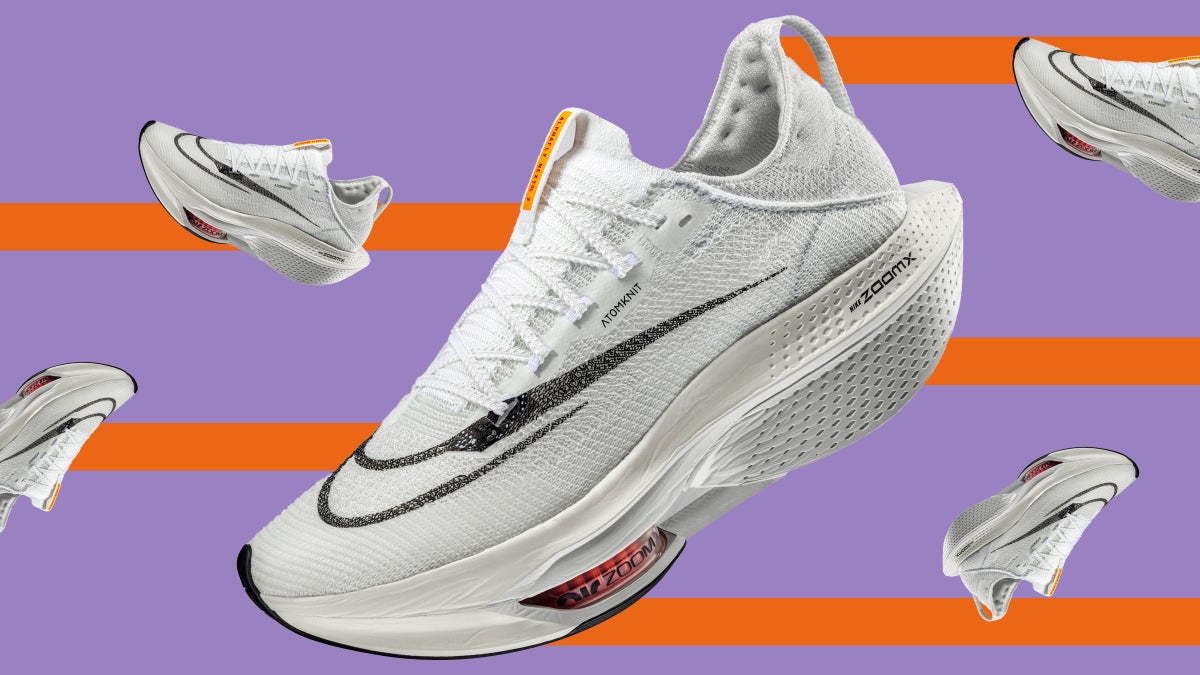Products You May Like
Get access to everything we publish when you
sign up for Outside+.
If I could run every run in super shoes, I would. And Nike’s Alphafly shoes are to blame.
When the company first introduced the Nike Air Zoom Alphafly Next% in 2020, it was designed with a midsole made from a combination of full-length ZoomX foam (the brand’s lightest and most resilient), a full-length curved carbon plate, and dual Nike Air Zoom pods under the forefoot.
The OG was a bona fide hit: Eliud Kipchoge wore a prototype to break the sub-2 marathon in Vienna in October 2019. Nike gave every U.S. Olympic Marathon Trials qualifier a pair of Alphaflys in Atlanta in March 2020. And Nell Rojas made headlines at the 2022 Boston Marathon when she broke her contract with Adidas and ran in Nike, because Adidas’ carbon-plated racing shoes didn’t work as well for her as the Vaporfly and Alphafly shoes.
How the Nike Alphafly 2 Has Changed
You can’t fix what isn’t broken, but you can improve upon it. And that’s just what Nike did with the Alphafly 2, which was just announced today. (And, thankfully, they did it without increasing the already steep $275 price tag). At first glance, the new Alphafly 2 doesn’t look too different from the first iteration, but subtle changes improve the shoe’s stability and transition from heel to toe to help you feel as fast during mile 26 as you did during mile one.
Runners who felt unstable on the original’s super cushy, but somewhat teetering, 35- to 39-millimeter stack height will appreciate the wider heel on the new version; that larger footprint makes taking turns at high speeds slightly less stress-inducing, and keeps you on pace when it counts.
RELATED: I Ran My Fastest 5k Ever in the Nike Pegasus 38
Nike also increased the heel-to-toe offset from four millimeters to eight, a noticeable tilt that encourages a more natural foot stance, tipping you onto the Air Zoom pods so you can capitalize on that propulsive feel. During a speed workout, I ran by feel during the harder efforts, and was genuinely surprised by just how fast my paces were (I didn’t feel like I was working that hard!) when I looked at my data afterward.
That additional responsiveness underfoot could be due to the fact that a few millimeters of ZoomX foam now wraps around under the Zoom Air Pods, giving you more energy return with every step. Nike actually changed the outsole material to a new, more durable rubber with better traction so they could use less of it and replace some of it with ZoomX foam. Before, I was afraid to wear the first-gen on anything other than super flat pavement, so that extra bit of tread was very welcome when I tried running in the second-gen on a bridle path next to my standard sidewalk route. As an added bonus, this rubber makes the shoe a little quieter (shoes with this much foam in them tend to make hollow popping sounds as they hit the ground).
One big area of improvement is the Atomknit 2.0 upper. It’s the same material that was used in 2020, but this time around it’s been engineered with zones that stretch or lock your foot down as well as more dense containment around the forefoot to keep it in place—a much appreciated feature for someone like me, whose toes suffered significantly over the course of two marathons in the original. During a six-mile run, I didn’t notice any slippage within the shoe.
These new features have increased the weight a tad (from 185 grams to 198 grams for a women’s size 8) but you’re getting more benefits from more material (like comfort pods made from Flyknit around the heel, which adds more cushioning with minimal weight), and I found the weight difference to be barely noticeable.
Who the Nike Alphafly 2 is For
As a non-elite marathon runner, what I love most about these shoes isn’t the fact that they might make me infinitesimally faster on race day; it’s that they make my legs feel so much better after workouts and long efforts, so I don’t need as long to recover and can jump back into runs feeling 100 percent. (If you don’t want to take my word for it, just look at Shalane Flanagan, who ran six back-to-back World Marathon Majors in 2021 in the Alphafly and Vaporfly—and ran the last one the fastest.) The Alphafly 2 doubles down on improving efficiency and running economy, without causing excess wear and tear on your body, all of which leads to improved endurance.
RELATED: What Makes Super Shoes Super?
Runners looking for a boost, both in terms of speed and recovery, can benefit from wearing the Alphafly on race day and during recovery runs. Super shoes like the Alphafly allow for better efficiency as you run, thanks to how much energy the foam can store and the propulsive effects of the carbon plate, according to a 2019 study in the journal Sports Medicine. This all can translate to better endurance, something every distance runner can appreciate.
The Bottom Line
Since Nike debuted the Alphafly, countless shoe brands have designed and released their own super shoes, many of which have similar benefits. And $275 is a significant investment for a racing shoe, even if it’s inspired by the only shoe that’s led to a sub-two-hour marathon time. But this is a shoe that’s worth its premium price.
The changes may be subtle, but Nike did a great job of improving upon what worked, and refining its ability to help any athlete—pro or otherwise—go after their personal best in the marathon.
RELATED: How to Buy a Beginner Running Shoe That Won’t Break the Bank
